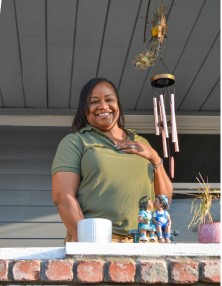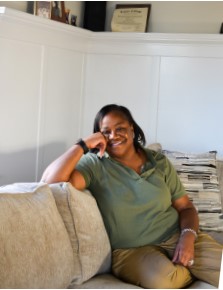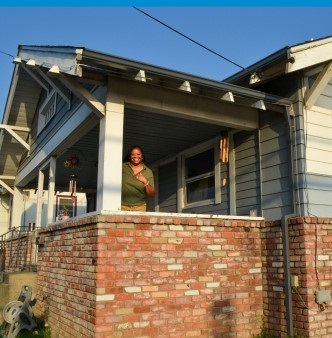Stakeholder
Profiles


I have always lived here. It’s roots, and it’s history, and it’s memories. – Charlotte, Homeowner
Mud pies. Ask Charlotte what comes to mind when she thinks of her home, and she’ll tell you it’s “Making mud pies in the yard, putting leaves on top. My mom watching me from the window. The next door neighbor having Christmas gatherings. Opening the doors to family members that were struggling… Just a lot of warmth and comfort.”
She has a deep well to draw from, because she grew up in this home on a hillside corner in Hayward. Charlotte has owned it since she and her sister purchased it from their parents – Hayward natives themselves.
This home is precious to Charlotte, one she looks forward to keeping in her family for future generations. A few years ago, though, the possibility seemed less secure. She remembers the mounting stress of repair needs coming to a head in January 2019, when her family suffered the sudden and devastating loss of her beloved nephew.
“We were planning his services,” Charlotte says, “and it was literally raining in my laundry room and in one of the bedrooms. Just water, coming down.” She recalls thinking, “I don’t want my roof to cave in,” but she hid the situation from her family to avoid adding weight to a household already so filled with heartache.

Charlotte was able to secure vital home repairs through Renew AC’s Home Preservation Program, which addressed the roof, repaired her siding, replaced some windows, and took care of work on her interior drywall, paint, and flooring. When her home was recently full again for her husband’s birthday, she says, “Everyone was like, oh my God, it looks like a whole different house.”
I’m rooted here. I don’t want to leave – Charlotte
It means Charlotte is focused not on the prospect of a failing roof, but on the ways the house brings her joy.
“Just warmth,” she says wistfully, “having people over. We love hosting, my husband loves to cook.” Her husband with his Dallas Cowboys games on in the family room while Charlotte enjoys her own shows in the back of the house. Keeping up a busy life as an assistant director at an East Bay school while her mate works for a local school district and coaches youth football. Taking pride in a pristine, wide-windowed front room looking out onto the street she grew up on. Offering a secure place for a family member to stay while he goes to college. Her front porch with its musical collection of windchimes and the figurines hand-painted by a family friend. A home full of family and food and noise, which she “wouldn’t change for anything.”

Without the worry of critical repairs, Charlotte’s home and her community can continue to be her history and her future. It can be the place where, as dating high schoolers, she and her husband would “stand together on the front porch,” and it can be the place where soon they’ll celebrate their nephew’s graduation from college. It can be the anchor from which future generations of her family will, like Charlotte, describe themselves as having “deep East Bay roots.” It won’t be rain in her laundry room or a drafty window. It will simply be home. “I have always lived here,” Charlotte says. “It’s roots, and it’s history, and it’s memories.

A Place To Call Home
Dr. Christine Ma is the Medical Director of Pediatric Encore Medical Clinic: – the Homeless Outreach Clinic at UCSF Benioff Children’s Hospital Oakland, an Associate Staff Physician in UCSF Benioff Children’s Hospital, and serves as Medical Director of Kerry’s Kids – a nonprofit mobile clinic that provides free medical care to underserved children at shelters and other community sites. Dr. Ma’s patients are children and their parents: families that are considered housing unstable. She sees how families have been forced into invisibility and the cost of this imperceptibility to all of us.
The families Dr. Ma sees are dealing with the daily crises decisions that come with housing instability. “So many families are spending their entire paychecks to live in hotels for a month, a week, or a day. They move between cars and motels. This is not a strategy that allows them to save for ‘move-in money’. They are spending all their income on their ‘in the moment costs.’
“The families that are the most unstable, never get to us at Children’s Homeless Outreach Clinic, unless I go out to find them. The most unstable might come to see us once, and then we can’t find them again. Their most immediate priority is basic living, having food, clothing, and shelter. Health care is important, but it ends up as a priority that can’t be met.”
Most of the families Dr. Ma serves have working parents, but the deck is stacked against them when housing costs outstrip wages. “But we can’t honestly believe that a two-parent household, both adults working full time, at minimum wage, and with kids to raise, can even earn enough to afford average rent, or even some affordable apartments.”
“Instead, they go from house to house to house, to car, to street, to motel, dragging their kids along with them, or splitting up their families until they find a place to stay. They continue to take care of their kids by working alternate shifts so that one of them is always at home for childcare. These are families that will never earn enough money to become housing secure.”
Parents in doubled-up living situation surrender some of their decision-making power for their family. “They are staying with family or friends. You can get by like this temporarily, but the guest family has no control over what happens in the household. They have no rights because they could be asked to leave at any moment, for any reason. The kid has asthma and the parent can’t tell the smoker to stop smoking in their own house. Their housing status is out of their control, and therefore it is a classic unstable living situation.”
Dr. Ma sees the emotional and physical toll housing instability takes on children. “We are allowing our children to float from place to place with nowhere to call home. This is happening during their formative years when they develop their sense of stability. Stability is core to the evolution of self-confidence, self-esteem, and their ability to accomplish great things…one of the most basic ways to feel stable is to know where you will sleep at night. Meanwhile, the kid’s asthma becomes worse and the parent must decide to remain in the unhealthy environment or face the impossible challenge of finding another place to live. In some situations, several families will share a common dwelling by hanging curtains or create other ways to divide the small space they live in. When one person has insomnia because of severe anxiety, depression, or social isolation, no one gets any sleep. Everyone becomes sleep deprived, depressed, and anxious.”
“A child might exhibit higher irritability, increased crying, or more frequent temper tantrums. A child who is emotionally worried is constantly living on the edge and having to be cautious. It means they will always have the ‘fight or flight’ response at the ready. That’s not how our bodies are intended to function. These kids show anxiety, depression, and hyper-difficulty when faced with the smallest stressors. Symptoms like these show up for years.” “In order to help, the child needs to be in an environment where they will be noticed. Once they are noticed, they will be advised to get help. Then, they have to be willing to accept the help they need. None of this happens unless the child or family stabilizes. One important way to stabilize a family is to give them a place that they can call home.

Renew AC participant
A calm fills the home of Linda St. Julian. Each artifact intentionally placed creates the ambiance she desires. She has lived in the home, built in 1910, for more than 30 years and it required repairs. Linda heard from Renew AC, an Alameda County Measure A1 program administered by Habitat for Humanity. They had funds for home repairs and she’d be a good candidate.
“I am a California native. I’ve always paid my taxes and I’m always helping other people. I grew up in Alameda until I was thirteen. Dad was mixed race but that didn’t keep him from knowing that he was a Black man. Alameda had military bases and housing projects. We moved to Oakland when Alameda began gentrifying. They pushed Black people out because Alameda was prime property.”
“One of my sisters bought this house back in 1973. She bought the house so my mother would always have a place to live. My sister died at 37, so I brought the house during the probate of her estate. My sister owned the house for 15 years and I’ve had it for thirtythree. Like her, I bought it to provide my mom a place to stay. Mom didn’t want to die in a hospital, so she died at home, in this house. My family will always keep it.”
“I’m sick of people calling and leaving flyers asking if I’m going to sell my house. If I sold it, where would I go?”
“Habitat for Humanity said the foundation and the walls of my house were in good condition. They said my house needed a new paint job, and they put a new roof on. The remodel of my kitchen included insulating it. When guests come over, they go right to the kitchen. I love my new kitchen. They painted everything blue because the color is so peaceful. A paint job makes all the difference. They worked so hard! The neighbors kept an eye on everything and, as a result, the same crew has painted three other houses on my block.”
“The construction workers made sure I had everything I wanted. I’m thankful for the program and stay connected with the people who helped me with the funds and pulling together my credit information. “ “I would advise homeowners to investigate programs like Renew AC that Habitat for Humanity operates because this is an effort to keep people in the Bay Area and in their properties.

Resident of Grayson Apartments In Berkeley
“Since moving into my new apartment, my depression has gotten better. I made a commitment to return this place in good condition. I’m just thankful, the relief has been great.”
Originally from New Jersey, Jonetta has lived in the Bay Area since the 1980’s when she drove a bus for Golden Gate Bridge District. After being furloughed from that job she spent much of her time and resources caring for her ailing grandmother. The ongoing toll of childhood trauma, mental illness and cancer ate away at her ability to work and disability benefits became her only source of income. A car accident and conflict over her grandmother’s estate further destabilized Jonetta’s life, causing her to be homeless. Eventually she was able to find a single room to live in for fifteen years, but it lacked a kitchen and a car crashing into the building made Jonetta realize she needed to find a better environment to deal with her health challenges.
“There is a resource program that attacks this issue from many different perspectives. The counselors operate an academy, and they will work with you on your housing stability. The current team helped me put in an application for a 1-bedroom apartment, a section 8 voucher, and to get on the waitlist for Grayson Apartments in Berkeley. When I was awarded the new apartment, an Eden Housing counselor helped me to transition and get funding for furniture.”
“I was just so happy to be in this new apartment with a chance to live normally. I remember the one room I stayed in for 15 years and I feel sad. I was barely existing. Now, I have a stove and a refrigerator. Before, it was only a microwave. I ate microwaved food 15 years. It’s one thing to give people a place to live just to get them out of the way, it’s another to provide housing.”
Grayson Street Apartments in Berkeley provides affordable housing to 22 low-income households, with seventeen of those apartments set aside for people with disabilities. Operated by Satellite Affordable Housing Associates (SAHA), Grayson was completed in October 2019 was supported with $691,394 of Measure A1 funds.

Jobs in Affordable Housing – Spotlight on Kottinger Gardens
Senior Community Manager at Midpen Housing’s Kottinger Gardens in Pleasanton “My parents were both born in Guatemala. They immigrated to the United States for opportunities. Two years after they came to this country, they sent for me and my brother. I was nine, and he was eight. We shared an apartment with people we didn’t know because my parents couldn’t afford their own apartment. That’s how it is when you are an immigrant. Everyone has to help each other.”
Nancy Pelayo is the senior community manager at Kottinger Gardens, an affordable senior rental development in Pleasanton. She lives on site, managing the facility, handling leasing and building community.
For ten years Nancy has worked for MidPen Housing managing affordable rental properties. “The most memorable moment in this work was my first rental [at another property]. The family had five kids, and they had been renting a one-bedroom apartment. I tried for a threebedroom unit, and they got approved. When I took the family to the apartment, they walked in, looked around – and huddled together in their new living room. They hugged each other, and they all cried. The experience was life-changing for me. I knew the kids would now have more space and more opportunities. The rent was sustainable and there would be extra money for the family to do other things.”
With $4.6 million from Measure A1’s Rental Development fund, MidPen expanded an existing affordable senior development from 50 to 131 cottages and apartments. The buildings are a combination of multi-family structures and cottages. “We wanted the environment to feed people’s spirits. Our residents are age 62 and older. There’s a game room, lively art is on all of the walls. We have a computer station, and the residents are creating their own lending library. We have gardening throughout, and people plant a little of everything!”
Kottinger Gardens provide apartments to people with a range of incomes, from 60% AMI – up to $53,610 per year for a household of 2, to 20% AMI – up to $17,870 for a household of 2 people in 2019. “Here, we see seniors from all walks of life. Some of them experienced a loss so they can’t sustain themselves anymore, some are still working but can’t afford market rent. Other seniors have no family and are by themselves. Each situation can be quite different.”

Alameda County resident and Renew AC participant
“All six of my siblings were born and raised in New York. After moving to San Francisco, I got a job at Head Start in Oakland. I worked at Head Start until I retired. I have always felt it was a good thing for the County and the City to help those who need it.”
Marilyn sees Renew AC as help in preserving the wealth and legacy she built for her family. “This is an opportunity for someone who has something to maintain it, improve it, and remain in it while building generational wealth.”
“While I’ve done advocacy on behalf of others, Renew AC is the first time I benefitted from a program.”
Renew AC did a marvelous job of updating my home with renovations. They brought all of the electrical up to code. The work on the walls showed true craftsmanship. They replaced my windows with double panes. I was freezing in here and the new windows make the house warmer. I had a wall furnace that heated the entire upstairs. Renew AC replaced it with central heat. My kitchen was updated using the original 1932 cabinets and hardware. I have new appliances and my floors have been resurfaced. My roof was replaced because there were three layers of the old roof under it. When it was done, I felt like I was moving into a new home. The house was fresh and clean. I finally, got things to look the way I wanted.”
“This renovation has been good for me as a retiree. To be able to have this work done gives me peace of mind. I can sleep at night without worrying about a wiring fire.”
“A home is like a piggy bank. When you pay a mortgage, you will always retain that investment as equity. When you rent, your money goes to the owner, the landlord, and you walk away with nothing.”
“As soon as they remodeled my kitchen, Chloe, my 23-yearold daughter, got dressed up to do a photoshoot in the middle of the kitchen. That said to me, this is what it looks like to pass wealth on to another generation.”
